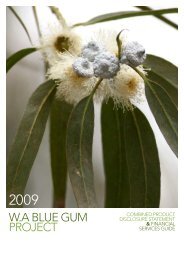download WA Blue Gum Project Product Disclosure Statement 2013
download WA Blue Gum Project Product Disclosure Statement 2013
download WA Blue Gum Project Product Disclosure Statement 2013
Create successful ePaper yourself
Turn your PDF publications into a flip-book with our unique Google optimized e-Paper software.
8. The South West of Western Australia is locatedcloser to the Japanese and other Asian exportmarkets thus having a significant freight advantage.This region can usually compete strongly withwoodchip exports from Chile, the southern States ofthe United States and South Africa. This shouldmean that Australia will maintain its market share inJapan. In the United States saw log production wasbecoming favoured over pulp log production butlimited new housing starts and efforts by the US tobolster their economy by exporting products thatwould have normally been absorbed by the localmarket could increase competition in the short term.9. Australia is even closer to the highly promisingIndonesian market where in recent years severalvery large pulp plants have been completed.Because of mismanagement, there is a shortage oflocal fibre and Australia (and especially the SouthWest of Western Australia) has the potential tobenefit.10. In March 2002, Australia made its first sale of woodchips to China. In that country there are two sets ofdynamics that provide opportunity:(a) strongly increasing demand, at about 80%per annum (the per capita use of paper isstill less than 10% of that in the UnitedStates);(b)a very quick and abrupt closing down ofnative forest logging for environmentalreasons, as major waterways werebecoming dangerously polluted.11. It is expected that India, the country with the world'ssecond largest population and the world's largestmiddle class, will increase its usage of paper. It isknown that India has made enquiries of Australianlog suppliers but in <strong>WA</strong> the current government isopposed to export of hardwood logs but has noobjections to export of plantation grown woodchips.India's paper usage per head is about 1% of that inthe United States. Other emerging markets areKorea and Taiwan. China has been a major supplierto Taiwan and this is likely to be curtailed.12. This <strong>Project</strong> has a Wood Purchase Agreement with<strong>WA</strong> Chip & Pulp Co Pty Ltd a wholly ownedsubsidiary of <strong>WA</strong>PRES which is a joint venturebetween Marubeni Corporation of Japan andNippon Paper Industries, two of Japan's largestpulp importers. Currently <strong>WA</strong>PRES is providingabout one third of its export woodchips fromEucalyptus globulus plantations it owns with twothirds coming from plantations managed by<strong>WA</strong>PRES on behalf of other entities such as <strong>WA</strong><strong>Blue</strong> <strong>Gum</strong> Limited so marketing of <strong>WA</strong> <strong>Blue</strong> <strong>Gum</strong>woodchips should be assured.14. The particular characteristics and location ofproperties in this <strong>Project</strong> strongly influence thereturns from sale of woodchips on export markets.Transport is a major cost and with the long termoutlook for oil prices to rise the significance of theclose proximity of land secured for the <strong>2013</strong> <strong>Project</strong>to process plants or Bunbury or Albany Portscannot be overstated when considering the pricesto be obtained by growers in the project.15. The Commonwealth Government declared underthe Carbon Farming initiative (CFI) that commercialplantations grown in Australia could not be used togain carbon credits whereas plantations grownoverseas are eligible. This appears anomalous anda case for a change in this ruling could besubstantiated.16. Growth in demand worldwide for high qualitywoodchips as derived from Eucalyptus globulusplantations has steadily increased and once theworld economy improves this is projected tocontinue. The demand from China for high qualitywoodchips had been increasing at a much higherrate than other countries and the tightening ofdemand over supply was one of the factors that ledto a 9.5% increase in the FOB price in 2008 forEucalyptus globulus woodchips. Due to increasingsupply of Eucalyptus globulus woodchips from 2012due to large plantation areas established in 2000 to2002 and the world economic downturn, woodchipprices fell by 7% in 2012. The current uncertainty inthe world economy makes short term predictions offuture prices difficult as so many factors areinvolved however the long term outlook is thatdemand and prices will increase. It is expected thatby the time the trees planted in the <strong>WA</strong> <strong>Blue</strong> <strong>Gum</strong>Limited <strong>2013</strong> <strong>Project</strong> are ready for harvest thatprices will have recovered.The information contained in this report has been gainedas a result of my own enquires and I have not relied onany representations made to me by the <strong>Project</strong> Manager,<strong>WA</strong>CAP Treefarms or any other person.Don Spriggins BSc (For), FIFA13. In-forest chipping methods are now being used aswell as transporting logs to fixed chip mills. Onlower yielding sites in-forest chipping techniquesare used to reduce the cost of chip production byreducing transport costs from forest to Port in thatchips, not logs, are transported.






